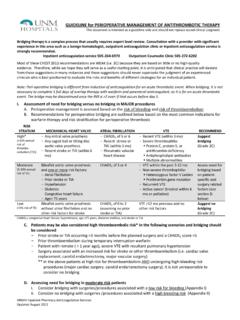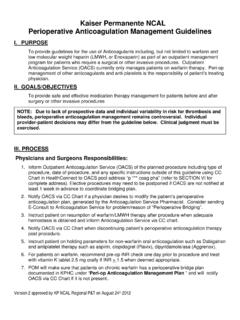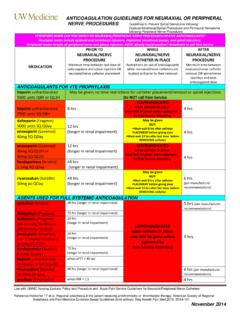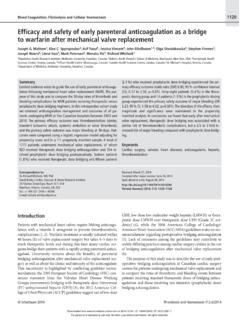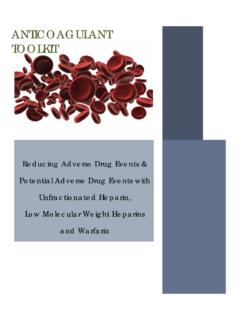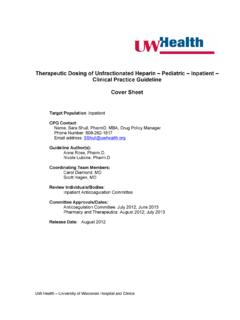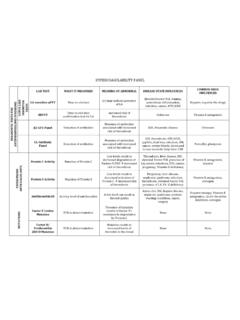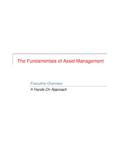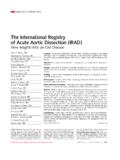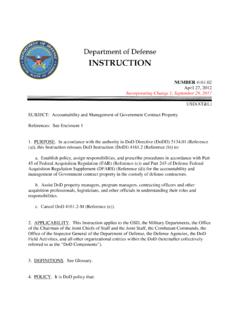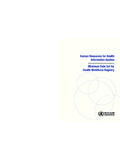Transcription of Rates, management, and outcome of rivaroxaban bleeding in ...
1 From by guest on December 10, 2015. For personal use only. Regular Article THROMBOSIS AND HEMOSTASIS. Rates, management , and outcome of rivaroxaban bleeding in daily care : results from the Dresden NOAC registry Jan Beyer-Westendorf,1 Kati Forster, 1. Sven Pannach,2 Franziska Ebertz,1 Vera Gelbricht,1 Christoph Thieme,1. 1 1. Franziska Michalski, Christina Kohler, Sebastian Werth,1 Kurtulus Sahin,3 Luise Tittl,1 Ulrike Hansel, 1. and Norbert Weiss1. 1. Center for Vascular Medicine and Department of Medicine III, Division of Angiology, and 2 Department of Medicine I, Division of Gastroenterology, University Hospital Carl Gustav Carus Dresden, Dresden, Germany; and 3 ClinStat GmbH, Institute for Clinical Research and Statistics, Cologne, Germany Worldwide, rivaroxaban is increasingly used for stroke prevention in atrial fibrillation and Key Points treatment of venous thromboembolism, but little is known about rivaroxaban -related In a real-world setting, bleeding complications in daily care .
2 Using data from a prospective, noninterventional annualized bleeding rates of oral anticoagulation registry of daily care patients (Dresden NOAC registry ), we analyzed major rivaroxaban bleeding rates, management , and outcome of rivaroxaban -related bleeding . Between October 1, are lower than those reported 2011, and December 31, 2013, 1776 rivaroxaban patients were enrolled. So far, 762. patients ( ) reported 1082 bleeding events during/within 3 days after last intake of for vitamin K antagonists. rivaroxaban ( minor, of nonmajor clinically relevant, and major bleeding Treatment of major according to International Society on Thrombosis and Haemostasis definition). In case of rivaroxaban bleeding is major bleeding , surgical or interventional treatment was needed in and pro- simple and rarely requires thrombin complex concentrate in In the time-to-first-event analysis, 100-patient- pro-coagulants; outcome at year rates of major bleeding were (95% confidence interval ) for stroke 90 days is better than that prevention in atrial fibrillation and (95% confidence interval ) for venous reported for vitamin K thromboembolism patients, respectively.
3 In the as-treated analysis, case fatality rates of antagonists. bleeding leading to hospitalizations were and at days 30 and 90 after bleeding , respectively. Our data indicate that, in real life, rates of rivaroxaban -related major bleeding may be lower and that the outcome may at least not be worse than that of major vitamin K antagonist bleeding , and probably better. This trial was registered at as identifier #NCT01588119. (Blood. 2014;124(6):955-962). Introduction For more than 5 decades, vitamin K antagonists (VKAs) had been routine coagulation monitoring is required and patients can be treated the standard of long-term anticoagulation in indications such as with a xed-dose regimen. Large phase 3 trials in SPAF and VTE. stroke prevention in atrial brillation (SPAF) and treatment of treatment compared rivaroxaban with VKA and consistently dem- venous thromboembolism (VTE). Although effective, VKA onstrated high ef cacy and safety for Major therapy is complicated because of the signi cant interindividual bleeding events were rare in these large phase 3 trials and the rate of variations in metabolism, numerous drug drug interactions, and the intracranial hemorrhage the most feared complication of antico- interaction with dietary intake of vitamin Therefore, routine agulant therapy was signi cantly reduced with rivaroxaban com- monitoring of the anticoagulation intensity is necessary.
4 In daily care , pared with ,13. the time in therapeutic range of VKA patients is approximately 50% However, bleeding is the most common side effect of rivaroxaban to 70%,2 which is a clear indicator of the problematic individual dose- and, as with VKA treatment, it has to be expected that rates, pattern, nding. As a result, thromboembolic as well as bleeding complica- and outcome of rivaroxaban -related bleeding in unselected daily tions with VKAs are common. The annual rates of major bleeding in care patients may be different from the favorable outcomes seen in VKA patients in daily care are estimated to be up to 8%.3-8 Furthermore, selected patients in clinical trials, because patients in daily care more in cases of major bleeding or bleeding requiring hospitalization often show signi cant comorbidities and are treated under a less during VKA therapy, case fatality rates were shown to be as high as intensive surveillance.
5 13% to 18%.7-9 Because routine coagulation monitoring tests are not generally The non-VKA oral anticoagulant (NOAC) rivaroxaban is a available for emergency situations during rivaroxaban therapy and selective inhibitor of the activated coagulation factor X (factor Xa). speci c reversal agents are lacking, there is a general fear that bleeding It has an excellent dose response relationship, few drug drug complications during rivaroxaban therapy cannot be adequately con- interactions, and no drug food interactions. As a consequence, no trolled and may result in poor outcomes. Submitted March 18, 2014; accepted May 14, 2014. Prepublished online as The publication costs of this article were defrayed in part by page charge Blood First Edition paper, May 23, 2014; DOI payment. Therefore, and solely to indicate this fact, this article is hereby marked advertisement in accordance with 18 USC section 1734. The online version of this article contains a data supplement.
6 There is an Inside Blood Commentary on this article in this issue. 2014 by The American Society of Hematology BLOOD, 7 AUGUST 2014 x VOLUME 124, NUMBER 6 955. From by guest on December 10, 2015. For personal use only. 956 BEYER-WESTENDORF et al BLOOD, 7 AUGUST 2014 x VOLUME 124, NUMBER 6. Using data from a large, prospective multicentric NOAC registry , All bleeding events were classi ed as minor, NMCR, or major bleeding the following objectives were addressed: using the International Society on Thrombosis and Haemostasis (ISTH). de nition14: c Rates of rivaroxaban -associated bleeding complications in daily Major bleeding was de ned as overt bleeding with any of the following: care ;. c Documented transfusion of at least 2 U RBCs;. c Distribution pattern of minor, nonmajor clinically relevant (NMCR). and major bleeding ; c Drop in hemoglobin .2 g/L;. c Surgical revision from bleeding ;. c management of rivaroxaban -associated bleeding with the focus c bleeding into critical site (intracranial, intraocular, intraarticular, retro- on surgical or interventional treatment and the use of pro-coagulant peritoneal, overt gastrointestinal bleeding ); or therapies; and c Fatal bleeding .
7 C All-cause and bleeding related mortality at 90 days after rivaroxaban -associated bleeding . NMCR was de ned as overt bleeding with any of the following: c Nonmajor bleeding compromising hemodynamics;. c Any bleeding leading to hospitalization;. c Subcutaneous hematoma larger than 25 cm2, or 100 cm2 if there was a traumatic cause;. Methods c Intramuscular hematoma documented by ultrasonography;. c Epistaxis that lasted for more than 5 minutes, was repetitive (ie, 2 or more Patients episodes of bleeding more extensive than spots and a handkerchief within 24 hours), or led to an intervention (eg, packing or electrocoagulation);. The Dresden NOAC registry (NCT01588119) is a large, prospective registry c Gingival bleeding occurring spontaneously (ie, unrelated to eating or in the administrative district of Dresden (Saxony), Germany. In this ongoing tooth brushing) or lasting for more than 5 minutes;. project, a network of more than 230 physicians from private practices and c Hematuria that was macroscopic and was spontaneous or lasted for more hospitals enroll patients treated with a NOAC, who are prospectively than 24 hours after instrumentation (eg, catheter placement or surgery) of followed up by the central registry of ce.
8 Patients are eligible if the following the urogenital tract;. inclusion criteria are met: c Macroscopic gastrointestinal hemorrhage, including at least 1 episode of c Planned NOAC anticoagulation for at least 3 months; rectal blood loss, if more than a few spots on toilet paper;. c Therapeutic NOAC indication including SPAF, deep vein thrombosis, c Hemoptysis, if more than a few speckles in the sputum and not occurring pulmonary embolism, and other indications; within the context of pulmonary embolism; or c Age .18 years; c Any other bleeding type considered to have clinical consequences for c Written informed consent; and a patient such as medical intervention; the need for unscheduled contact c Availability for follow-up by telephone visits. (visit or telephone call) with a physician, temporary cessation of a study drug, or temporary cessation of a study drug; or associated with pain or No exclusion criteria apply. Patients are followed up by telephone visits impairment of activities of daily life.
9 At 30 days after enrollment and quarterly thereafter to collect data on the ef cacy, safety, and management of NOAC therapy in daily care . Minor bleeding was de ned as every overt bleeding event that does not ful ll the criteria of major or NMCR bleeding . Data collection and classification of bleeding complications Major cardiovascular events were de ned as fatal or nonfatal cardiovas- cular complications events consisting of centrally adjudicated events as During all visits, suspected bleeding events were documented in the case follows: report form and additional data (laboratory tests, imaging results, reports from c Acute coronary syndrome, including unstable angina, non ST-elevation treating physician, protocols of surgery or intervention, discharge letters, death certi cates, and autopsy reports as applicable) were collected for central myocardial infarction, and ST-elevation myocardial infarction;. c Stroke or transient ischemic attack or systemic embolism.
10 Adjudication and bleeding event classi cation. c Deep vein thrombosis or pulmonary embolism; or bleeding management was assessed using patient narrative and all c Any other fatal cardiovascular event. relevant medical documents, including: the objectively documented necessity of interventional or surgical treatment; rates and amount of red blood cell (RBC), plasma or platelet transfusions; or the use of pro-coagulants such outcome of bleeding complications as prothrombin complex concentrate (PCC), factor VIII inhibitor bypass Mortality rates after rivaroxaban -related bleeding were assessed at days 30. activator, or recombinant factor VII concentrate. and 90 postbleeding. Furthermore, for comparison with available data for outcome of bleeding event was established for days 30 and 90. VKA-related major bleeding (often de ned as bleeding leading to postbleeding using documentation of the acute bleeding episode as well as hospitalization),7,9 the case fatality rate (all-cause mortality) of all rivaroxaban data from the next scheduled phone visits.
